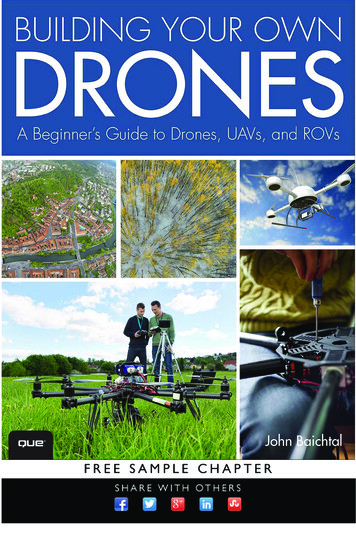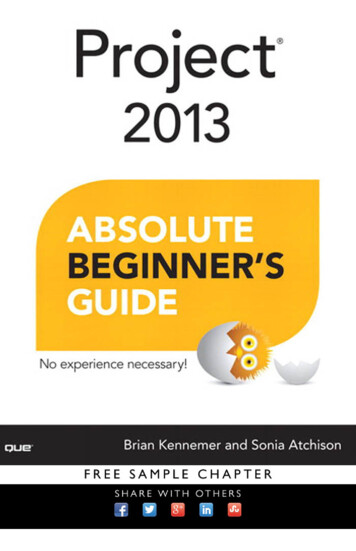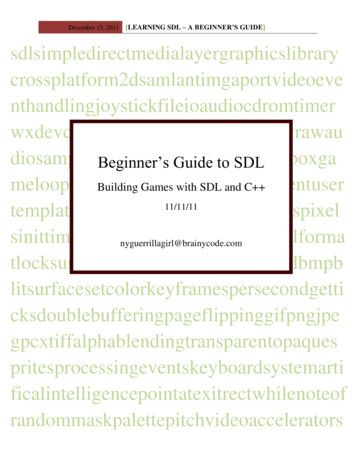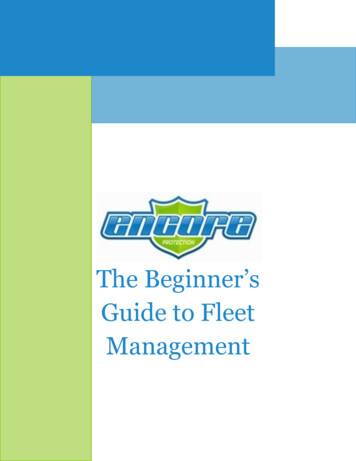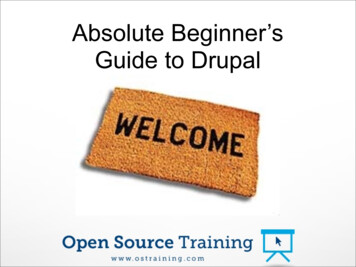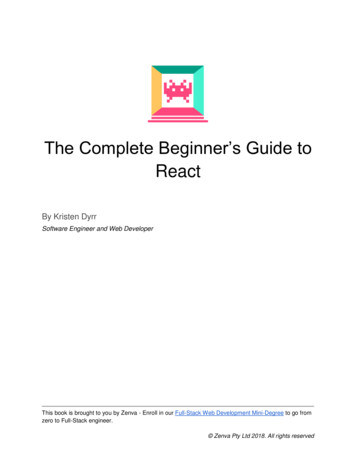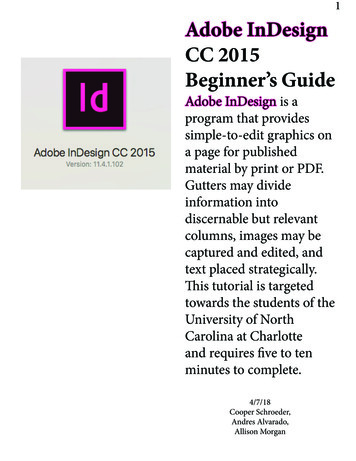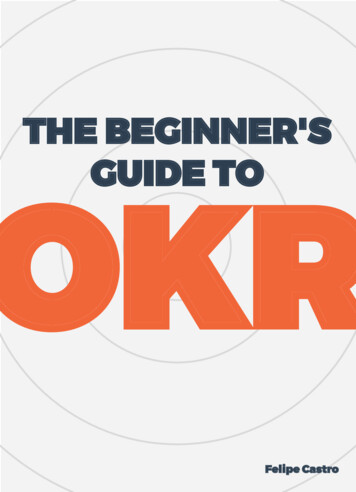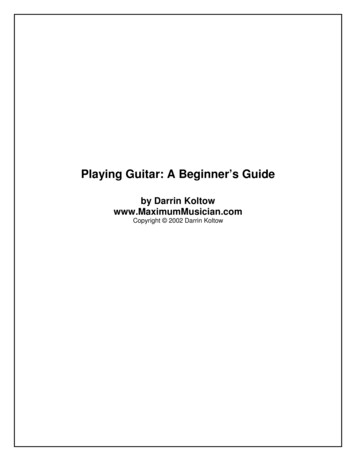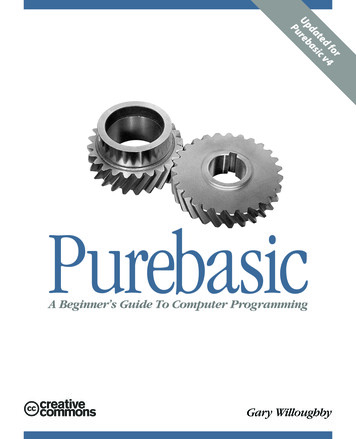
Transcription
ordf 4te ic vd a asUp r e bPuPurebasicA Beginner’s Guide To Computer ProgrammingGary Willoughby
PurebasicA Beginners Guide To Computer ProgrammingGary Willoughby
PureBasic - A Beginner’s Guide To Computer Programmingby Gary WilloughbyCopyright 2006 Gary WilloughbyThis book and all included source materials such as diagrams, photos and PureBasic source code isdistributed under the Creative Commons Attribution Non-Commercial Share Alike License. Moredetails can be found here: c is a registered trademark of Fantaisie Software. PureBasic and all provided tools andcomponents contained within the PureBasic package are Copyright 2006 Fantaisie Software.Fantaisie Software10, rue de Lausanne67640 FegersheimFrancewww.purebasic.comPublished 2006, by Aardvark Global Publishing.EditorGary WilloughbyPrint HistoryJuly 2006 - First EditionDisclaimerWhile every precaution has been taken in the preparation of this book and the programs containedwithin it, the author and publisher assumes no responsibility whatsoever for errors, omissions, or fordamages resulting from the use of the information or programs contained herein. The author orpublisher shall not be liable if incidental or consequential damages occur in connection with, or arisingfrom, the furnishings, performance, or use of the programs, associated instructions, and/or claims ofproductivity gains. All information contained herein is considered accurate at time of publication butbecause PureBasic is a language in a constant state of refinement and development, some informationover time may be rendered out-of-date. For up to date news and information regarding PureBasicplease refer to www.purebasic.com.TrademarksTrademarked names appear throughout this book. Rather than list the names and entities that ownthe trademarks or insert a trademark symbol with each mention of the trademarked name, thepublisher states that it is using the names for editorial purposes only and to the benefit of thetrademark owner, with no intention of infringing on that trademark.
DedicationDedicated to my girlfriend, Sara Jane Gostick and her dog ‘Stella’ for putting up with many lonelynights while I wrote this book and for the encouragement (and chicken dinners) she always givesme.AcknowledgmentsThanks to Fred and the Purebasic team for the Purebasic language, keep up the good work, it rocks!Thanks to Paul Dixon for clarifying some of the details regarding binary encoding of floating pointnumbers.Thanks to Timo Harter for helping to choose what Purebasic data types would best substitute theWin32 API types, and for demonstrating how to retrieve different strings from memory via thedifferent Win32 API String pointer types.“With great power there must also come great responsibility!”--Ben Parker (Spiderman’s Uncle)Code examples contained in this book can be downloaded freely fromwww.pb-beginners.co.ukISBN 1-4276-0428-2 19/7/2006
vTable of ContentsPreface . . . . . . . . . . . . . . . . . . . . . . . . . . . . . . . . . . . . . . . . . . . . . . . . . . . . . . . . . . . . . . . . .ixI.The Core Language . . . . . . . . . . . . . . . . . . . . . . . . . . . . . . . . . . . . . . . . . . . . . . . . . . . . .11. Getting Started . . . . . . . . . . . . . . . . . . . . . . . . . . . . . . . . . . . . . . . . . . . . . . . . . . . . . . . .3The History Of PureBasic . . . . . . . . . . . . . . . . . . . . . . . . . . . . . . . . . . . . . . . . . . . . . . . . . . . . . . . . . .3The Development Philosophy Of PureBasic . . . . . . . . . . . . . . . . . . . . . . . . . . . . . . . . . . . . . . . . . . .5A First Look At The IDE . . . . . . . . . . . . . . . . . . . . . . . . . . . . . . . . . . . . . . . . . . . . . . . . . . . . . . . . . . .6How To Run PureBasic Programs . . . . . . . . . . . . . . . . . . . . . . . . . . . . . . . . . . . . . . . . . . . . . . . . . . .7The Debugger . . . . . . . . . . . . . . . . . . . . . . . . . . . . . . . . . . . . . . . . . . . . . . . . . . . . . . . . . . . . . . . . . . .8A Note On Program Structure . . . . . . . . . . . . . . . . . . . . . . . . . . . . . . . . . . . . . . . . . . . . . . . . . . . . . .8Introducing The PureBasic Help File . . . . . . . . . . . . . . . . . . . . . . . . . . . . . . . . . . . . . . . . . . . . . . . .92. Data Types . . . . . . . . . . . . . . . . . . . . . . . . . . . . . . . . . . . . . . . . . . . . . . . . . . . . . . . . . . .10Built-In Data Types . . . . . . . . . . . . . . . . . . . . . . . . . . . . . . . . . . . . . . . . . . . . . . . . . . . . . . . . . . . . . .10Numbers . . . . . . . . . . . . . . . . . . . . . . . . . . . . . . . . . . . . . . . . . . . . . . . . . . . . . . . . . . . . . . . . . . . . . .10Strings . . . . . . . . . . . . . . . . . . . . . . . . . . . . . . . . . . . . . . . . . . . . . . . . . . . . . . . . . . . . . . . . . . . . . . . .12Variables And Constants . . . . . . . . . . . . . . . . . . . . . . . . . . . . . . . . . . . . . . . . . . . . . . . . . . . . . . . . . .123. Operators . . . . . . . . . . . . . . . . . . . . . . . . . . . . . . . . . . . . . . . . . . . . . . . . . . . . . . . . . . . .18An Introduction To Operators . . . . . . . . . . . . . . . . . . . . . . . . . . . . . . . . . . . . . . . . . . . . . . . . . . . . .18Operator Precedence . . . . . . . . . . . . . . . . . . . . . . . . . . . . . . . . . . . . . . . . . . . . . . . . . . . . . . . . . . . .33Expression Notes . . . . . . . . . . . . . . . . . . . . . . . . . . . . . . . . . . . . . . . . . . . . . . . . . . . . . . . . . . . . . . .344. Conditional Statements And Loops . . . . . . . . . . . . . . . . . . . . . . . . . . . . . . . . . . . . . .37Boolean Logic . . . . . . . . . . . . . . . . . . . . . . . . . . . . . . . . . . . . . . . . . . . . . . . . . . . . . . . . . . . . . . . . . .37The ‘If’ Statement . . . . . . . . . . . . . . . . . . . . . . . . . . . . . . . . . . . . . . . . . . . . . . . . . . . . . . . . . . . . . . .38The ‘Select’ Statement . . . . . . . . . . . . . . . . . . . . . . . . . . . . . . . . . . . . . . . . . . . . . . . . . . . . . . . . . . . .41Loops . . . . . . . . . . . . . . . . . . . . . . . . . . . . . . . . . . . . . . . . . . . . . . . . . . . . . . . . . . . . . . . . . . . . . . . . .435. Other Data Structures . . . . . . . . . . . . . . . . . . . . . . . . . . . . . . . . . . . . . . . . . . . . . . . . .49Structures . . . . . . . . . . . . . . . . . . . . . . . . . . . . . . . . . . . . . . . . . . . . . . . . . . . . . . . . . . . . . . . . . . . . .49Arrays . . . . . . . . . . . . . . . . . . . . . . . . . . . . . . . . . . . . . . . . . . . . . . . . . . . . . . . . . . . . . . . . . . . . . . . .52Linked Lists . . . . . . . . . . . . . . . . . . . . . . . . . . . . . . . . . . . . . . . . . . . . . . . . . . . . . . . . . . . . . . . . . . . .62Sorting Arrays And Linked Lists . . . . . . . . . . . . . . . . . . . . . . . . . . . . . . . . . . . . . . . . . . . . . . . . . . .676. Procedures And Subroutines . . . . . . . . . . . . . . . . . . . . . . . . . . . . . . . . . . . . . . . . . . .71Why Use Procedures Or Subroutines? . . . . . . . . . . . . . . . . . . . . . . . . . . . . . . . . . . . . . . . . . . . . . . .71Subroutines . . . . . . . . . . . . . . . . . . . . . . . . . . . . . . . . . . . . . . . . . . . . . . . . . . . . . . . . . . . . . . . . . . . .71Procedure Basics . . . . . . . . . . . . . . . . . . . . . . . . . . . . . . . . . . . . . . . . . . . . . . . . . . . . . . . . . . . . . . . .74Program Scope . . . . . . . . . . . . . . . . . . . . . . . . . . . . . . . . . . . . . . . . . . . . . . . . . . . . . . . . . . . . . . . . .76The ‘Global’ Keyword . . . . . . . . . . . . . . . . . . . . . . . . . . . . . . . . . . . . . . . . . . . . . . . . . . . . . . . . . . . .78The ‘Protected’ Keyword . . . . . . . . . . . . . . . . . . . . . . . . . . . . . . . . . . . . . . . . . . . . . . . . . . . . . . . . . .79The ‘Shared’ Keyword . . . . . . . . . . . . . . . . . . . . . . . . . . . . . . . . . . . . . . . . . . . . . . . . . . . . . . . . . . .80
viTable of ContentsThe ‘Static’ Keyword . . . . . . . . . . . . . . . . . . . . . . . . . . . . . . . . . . . . . . . . . . . . . . . . . . . . . . . . . . . . .82Passing Variables To Procedures . . . . . . . . . . . . . . . . . . . . . . . . . . . . . . . . . . . . . . . . . . . . . . . . . . .83Passing Arrays To Procedures . . . . . . . . . . . . . . . . . . . . . . . . . . . . . . . . . . . . . . . . . . . . . . . . . . . . .86Passing Linked Lists To Procedures . . . . . . . . . . . . . . . . . . . . . . . . . . . . . . . . . . . . . . . . . . . . . . . .88Returning A Value From Procedures . . . . . . . . . . . . . . . . . . . . . . . . . . . . . . . . . . . . . . . . . . . . . . . .917. Using Built-In Commands . . . . . . . . . . . . . . . . . . . . . . . . . . . . . . . . . . . . . . . . . . . . . .93Using The PureBasic Helpfile . . . . . . . . . . . . . . . . . . . . . . . . . . . . . . . . . . . . . . . . . . . . . . . . . . . . .93PB Numbers And OS Identifiers . . . . . . . . . . . . . . . . . . . . . . . . . . . . . . . . . . . . . . . . . . . . . . . . . . .95Examples Of Common Commands . . . . . . . . . . . . . . . . . . . . . . . . . . . . . . . . . . . . . . . . . . . . . . . . .98Handling Files . . . . . . . . . . . . . . . . . . . . . . . . . . . . . . . . . . . . . . . . . . . . . . . . . . . . . . . . . . . . . . . . .104Read The Helpfile . . . . . . . . . . . . . . . . . . . . . . . . . . . . . . . . . . . . . . . . . . . . . . . . . . . . . . . . . . . . . .1108. Good Programming Style . . . . . . . . . . . . . . . . . . . . . . . . . . . . . . . . . . . . . . . . . . . . . .111Why Bother Formatting Code . . . . . . . . . . . . . . . . . . . . . . . . . . . . . . . . . . . . . . . . . . . . . . . . . . . . .111The Value Of Comments . . . . . . . . . . . . . . . . . . . . . . . . . . . . . . . . . . . . . . . . . . . . . . . . . . . . . . . . .112My Coding Format . . . . . . . . . . . . . . . . . . . . . . . . . . . . . . . . . . . . . . . . . . . . . . . . . . . . . . . . . . . . . .113Golden Rules For Writing Easily Readable Code . . . . . . . . . . . . . . . . . . . . . . . . . . . . . . . . . . . . . .116How To Minimize And Handle Errors . . . . . . . . . . . . . . . . . . . . . . . . . . . . . . . . . . . . . . . . . . . . . .117II Graphical User Interfaces . . . . . . . . . . . . . . . . . . . . . . . . . . . . . . . . . . . . . . . . . . . . .1299. Creating User Interfaces . . . . . . . . . . . . . . . . . . . . . . . . . . . . . . . . . . . . . . . . . . . . . .131Console Programs . . . . . . . . . . . . . . . . . . . . . . . . . . . . . . . . . . . . . . . . . . . . . . . . . . . . . . . . . . . . . .131Creating Native User Interfaces . . . . . . . . . . . . . . . . . . . . . . . . . . . . . . . . . . . . . . . . . . . . . . . . . . .137Understanding Events . . . . . . . . . . . . . . . . . . . . . . . . . . . . . . . . . . . . . . . . . . . . . . . . . . . . . . . . . .139Adding Gadgets . . . . . . . . . . . . . . . . . . . . . . . . . . . . . . . . . . . . . . . . . . . . . . . . . . . . . . . . . . . . . . . .140Adding A Menu . . . . . . . . . . . . . . . . . . . . . . . . . . . . . . . . . . . . . . . . . . . . . . . . . . . . . . . . . . . . . . . .148Menu Keyboard Shortcuts . . . . . . . . . . . . . . . . . . . . . . . . . . . . . . . . . . . . . . . . . . . . . . . . . . . . . . .153Including Graphics In Your Program . . . . . . . . . . . . . . . . . . . . . . . . . . . . . . . . . . . . . . . . . . . . . . .156A First Look At The New Visual Designer . . . . . . . . . . . . . . . . . . . . . . . . . . . . . . . . . . . . . . . . . . .162III Graphics And Sound . . . . . . . . . . . . . . . . . . . . . . . . . . . . . . . . . . . . . . . . . . . . . . . . . .16510. 2D Graphics . . . . . . . . . . . . . . . . . . . . . . . . . . . . . . . . . . . . . . . . . . . . . . . . . . . . . . . . .1672D Drawing Commands . . . . . . . . . . . . . . . . . . . . . . . . . . . . . . . . . . . . . . . . . . . . . . . . . . . . . . . . .167Saving Images . . . . . . . . . . . . . . . . . . . . . . . . . . . . . . . . . . . . . . . . . . . . . . . . . . . . . . . . . . . . . . . . .179Introducing Screens . . . . . . . . . . . . . . . . . . . . . . . . . . . . . . . . . . . . . . . . . . . . . . . . . . . . . . . . . . . .181Sprites . . . . . . . . . . . . . . . . . . . . . . . . . . . . . . . . . . . . . . . . . . . . . . . . . . . . . . . . . . . . . . . . . . . . . . .19211. 3D Graphics . . . . . . . . . . . . . . . . . . . . . . . . . . . . . . . . . . . . . . . . . . . . . . . . . . . . . . . .203An Overview Of The OGRE Engine . . . . . . . . . . . . . . . . . . . . . . . . . . . . . . . . . . . . . . . . . . . . . . . .203A Gentle Beginning . . . . . . . . . . . . . . . . . . . . . . . . . . . . . . . . . . . . . . . . . . . . . . . . . . . . . . . . . . . .206A Simple First Person Camera . . . . . . . . . . . . . . . . . . . . . . . . . . . . . . . . . . . . . . . . . . . . . . . . . . . .215A Little More Advanced . . . . . . . . . . . . . . . . . . . . . . . . . . . . . . . . . . . . . . . . . . . . . . . . . . . . . . . . .221What’s Next? . . . . . . . . . . . . . . . . . . . . . . . . . . . . . . . . . . . . . . . . . . . . . . . . . . . . . . . . . . . . . . . . . .226
Table of Contentsvii12. Sound . . . . . . . . . . . . . . . . . . . . . . . . . . . . . . . . . . . . . . . . . . . . . . . . . . . . . . . . . . . . . .227Wave Files . . . . . . . . . . . . . . . . . . . . . . . . . . . . . . . . . . . . . . . . . . . . . . . . . . . . . . . . . . . . . . . . . . . .227Module Files . . . . . . . . . . . . . . . . . . . . . . . . . . . . . . . . . . . . . . . . . . . . . . . . . . . . . . . . . . . . . . . . . .231Mp3’s . . . . . . . . . . . . . . . . . . . . . . . . . . . . . . . . . . . . . . . . . . . . . . . . . . . . . . . . . . . . . . . . . . . . . . . .233CD Audio . . . . . . . . . . . . . . . . . . . . . . . . . . . . . . . . . . . . . . . . . . . . . . . . . . . . . . . . . . . . . . . . . . . . .237IV Advanced Topics . . . . . . . . . . . . . . . . . . . . . . . . . . . . . . . . . . . . . . . . . . . . . . . . . . . . .24313. Beyond The Basics . . . . . . . . . . . . . . . . . . . . . . . . . . . . . . . . . . . . . . . . . . . . . . . . . . .245Compiler Directives And Functions . . . . . . . . . . . . . . . . . . . . . . . . . . . . . . . . . . . . . . . . . . . . . . . .245Advanced Compiler Options . . . . . . . . . . . . . . . . . . . . . . . . . . . . . . . . . . . . . . . . . . . . . . . . . . . . .252Parsing Command Line Parameters . . . . . . . . . . . . . . . . . . . . . . . . . . . . . . . . . . . . . . . . . . . . . . .259A Closer Look At Numeric Data Types . . . . . . . . . . . . . . . . . . . . . . . . . . . . . . . . . . . . . . . . . . . . .262Pointers . . . . . . . . . . . . . . . . . . . . . . . . . . . . . . . . . . . . . . . . . . . . . . . . . . . . . . . . . . . . . . . . . . . . . .269Threads . . . . . . . . . . . . . . . . . . . . . . . . . . . . . . . . . . . . . . . . . . . . . . . . . . . . . . . . . . . . . . . . . . . . . .279Dynamic Link Libraries . . . . . . . . . . . . . . . . . . . . . . . . . . . . . . . . . . . . . . . . . . . . . . . . . . . . . . . . .287The Windows Application Programming Interface . . . . . . . . . . . . . . . . . . . . . . . . . . . . . . . . . . .293VAppendices . . . . . . . . . . . . . . . . . . . . . . . . . . . . . . . . . . . . . . . . . . . . . . . . . . . . . . . . .303A. Useful Internet Links . . . . . . . . . . . . . . . . . . . . . . . . . . . . . . . . . . . . . . . . . . . . . .305B. Helpful Charts . . . . . . . . . . . . . . . . . . . . . . . . . . . . . . . . . . . . . . . . . . . . . . . . . . . .307C. Glossary . . . . . . . . . . . . . . . . . . . . . . . . . . . . . . . . . . . . . . . . . . . . . . . . . . . . . . . . .317Index . . . . . . . . . . . . . . . . . . . . . . . . . . . . . . . . . . . . . . . . . . . . . . . . . . . . . . . . . . . . . . . . .332
ixPrefaceAbout this BookThis book provides a quick introduction to the PureBasic programming language. PureBasic’spopularity has increased significantly in the past few years, being used for many purposes such asrapid software prototyping, creation of commercial applications and games, Internet CGI applications,while some people just use it for small utilities. This book has been written, with the complete novicein mind. We all need to start somewhere and I believe PureBasic is a fantastic first leap into theprogramming world. With PureBasic becoming more and more widely used, many people are startingout and finding they need the occasional push in the right direction or need an explanation of a certainfeature or oddity. This book is to guide novices through their first steps and to give the seasonedprogrammer a quick overview of the language.This Book’s ScopeAlthough this book covers the essentials of the PureBasic language, I’ve kept this book’s scope quitenarrow to make sure it’s not information overload for new users. Sometimes this text will refer toconcepts and syntax in a simplistic way to be used as a stepping stone to more advanced texts or as acomplement to the existing PureBasic helpfile.For example I won’t talk much about how easy it is to use DirectX or OpenGL directly in PureBasic,otherwise this book would be triple in size and although topics such as pointers, threads and theWin32 API is talked about later in this book, don’t expect too many fancy examples as I’ve only givenan overview to such advanced topics.PureBasic raises the bar to not only what a Basic language should be but also what all languages shouldbe. Clean, uncluttered syntax, small compiled executable files and a fantastically active community ofprogrammers. Hopefully this book will give you a clear understanding of the core features of PureBasicand the design goals and philosophies behind its creation and hopefully make you want to learn more.
xPrefaceDespite this books limited scope, I think you will find this a great first book on PureBasic which willalso give you a solid grounding on programming in general if you were to migrate to other languages.You will learn everything you need to start writing useful standalone programs. By the time you’vefinished this book, you will have learned not only the essentials of the language itself, but also how toapply that knowledge to day-to-day tasks. You will also be better equipped to tackle more advancedtopics as they come your way.This Book’s StructureMuch of this book is designed to introduce you to PureBasic as quickly as possible and is organized bypresenting the major language features a section at a time. Each chapter is fairly self contained butlater chapters, especially the more advanced ones, use ideas introduced earlier. For example, when weget to graphical user interfaces and graphics, I’ll assume you now understand procedures andstructures.Part I: The Core LanguageThis part of the book is a straightforward bottom-up explanation of the major language features, suchas types, procedures, structures and so on. Most of the examples given are not really very useful asstandalone programs but are there to demonstrate and explain the current topic.Chapter 1, Getting StartedHe we start with a quick introduction to PureBasic and the history behind the language. An overviewon how to run a PureBasic program from the IDE and what the debugger is for.Chapter 2, Data TypesIn this chapter I start by listing and explaining all the available built-in data types, such as Strings,number types and constants. Usage guidelines are given for all the built-in data types as well asinformation on memory usage and where applicable, numerical limits.Chapter 3, OperatorsHere I explain the basic means to actually assign values to variables and explain what operators areneeded for calculating data. A full explanation is given for all operators along with diagrams andexamples. The ‘Debug’ command is also introduced here as it is one of the most useful commands inthe PureBasic language and its importance should be learned early on.Chapter 4, Conditional Statements And LoopsIn this chapter I explain how PureBasic handles boolean values, the ‘If’ and ‘Select’ statements areintroduced and loops are explained and demonstrated. Examples and full explanations are given.Chapter 5, Other Data StructuresThis chapter reveals how to create and use other methods for storing and organizing data, such as userdefined structures, arrays and linked lists. Full explanations and examples are also given.
PrefacexiChapter 6, Procedures And SubroutinesProcedures and Subroutines are an essential part of programming in any language as they can be usedto execute sections of code (along with variable parameters in the case of procedures) from any part ofthe running program. This makes programming easier as the entire program can then be broken downinto easily manageable sections and this modular code can then be reused time and time again.Chapter 7, Using Built-In CommandsThis chapter demonstrates some of the most widely used built-in commands. It’s not a completereference or guide to every single command of every library but it will give you a good grounding onhow and when to use the built-in libraries. An explanation is given on Handles and IDs, both of whichare simple to understand but sometimes easily confused.Chapter 8, Good Programming StyleThis chapter gives you a guide on good programming practices for use throughout this book andprovides an overview on simple error handling. When programming in any language, errors are alwaysa problem, be it a simple typo or a bug in the language itself. This chapter also deals with ways in whichyou can be more conscious of not introducing errors and how and why you should test for errors inyour program and how to react if one is found.Part II: Graphical User InterfacesNearly every program nowadays has a user interface of some description and here I will show you howto create one. Building on ideas and examples of creating a console application, you will eventuallylearn how to construct window based applications along with standard controls (gadgets) such asmenus, buttons and graphics.Chapter 9, Creating User InterfacesHere I show you how you can built your own user interfaces. Starting off by explaining anddemonstrating console applications and then moving on to creating native window based interfaces.Events are also described and examples are given on how to react when an event is detected withinyour interface. The bundled visual form designer is also given an overview here.Part III: Graphics And SoundGraphics and sound have an important role in nearly every computer system today. This section dealswith playing sounds and ways of displaying graphics on the screen and the manipulation of thesegraphics, be it in 2D or 3D.Chapter 10, 2D GraphicsThis chapter introduces two dimensional graphics such as lines and shapes and how they are drawnon the screen. It also deals with sprites (images that can be displayed and manipulated) and anexplanation of screens and double buffering is also given.Chapter 11, 3D GraphicsThe three dimensional graphics in PureBasic are provided by the OGRE engine. An overview and a fewexamples are given to demonstrate what is possible with this engine. The OGRE engine is stillundergoing development and is still being integrated fully into PureBasic, but some nice things are stillpossible.
xiiPrefaceChapter 12, SoundThis chapter covers how to use sound within PureBasic and covers how to load and play familiar soundformats.Part IV: Advanced TopicsThe last section deals with things which a novice would find very advanced. The topics contained hereare not necessary to understand to write fully functioning useful programs but they can achieve somethings that ordinary methods cannot. This section is to wet your appetite for knowledge to improveyour understanding of PureBasic and programming in general.Chapter 13, Beyond The BasicsHere the topics covered are advanced memory management using pointers. Compiler directives areexplained and a how-to guide is written for DLL creation. There is also a section on the WindowsApplication Programming Interface.Part V: AppendicesThis is the final section of this book and it ends with appendices that direct the reader to useful pageson the Internet, provides helpful charts and includes a comprehensive glossary of words and terms.PrerequisitesI hope that you know how to use a computer, there won’t be much talk on how to use a mouse or whatan icon is, but this book assumes you are a complete novice to computer programming, not only withPureBasic, but in general.All you will need to start programming today is a little bit of time and a copy of PureBasic, availablefrom www.purebasic.com
IThe CoreLanguageIn this section, we will study the PureBasic language itself. I call this part ‘The Core Language’, becauseour focus will be on the essentials of PureBasic programming: its built-in types, statements andexpressions. By the time you finish reading this section and studying the examples, you’ll be ready towrite programs yourself.The word ‘Core’ in the title is used on purpose, because this section is not an exhaustive document onevery minute detail of PureBasic. While I may skip certain things along the way, the basics you learnhere will stand you in very good stead for when the unknown pops up. There is also a mention of thehistory and development philosophy of PureBasic for those who are interested.
13Getting StartedThis first chapter starts with a brief history of PureBasic and then takes a quick look at how to runPureBasic programs. Its main goal is to get you set up to compile and run PureBasic programs on yourown computer, so you can work along with the examples and tutorials given in this book. Along theway we’ll study different ways you can compile from within PureBasic - just enough to get you started.We’ll also take a look at the included IDE that comes with the standard installation of PureBasic. Itlooks a little daunting for new users but after an overview and a little tutorial, things will look less scaryThe History Of PureBasicPureBasic started life in 1995 as a command-set expansion for BlitzBasic after PureBasic’s author,Frédéric Laboureur hit many limitations with BlitzBasic while programming an application called‘TheBoss’, a powerful application launcher for the Commodore Amiga. The expansion named ‘NCS’(NewCommandSet) was entirely coded using 68000 assembly, as all new commands had to be codedin assembly at this time of Blitz’s development. Fred’s progress was quite slow to begin with as gooddocumentation was hard to find for assembly programming and of course online forums didn’t thenexist for BlitzBasic plug-in programming.Development of ‘NCS’ continued for about a year after which Fred received very positive commentsregarding his work, through which he became very familiar with assembly programming anddebugging. He was also astonished with the incredible things that could be achieved with an old 68000processor if everything was programmed correctly.Around this time, IBM PowerPC based processor cards for the Amiga started to appear and were a verypowerful alternative to the Motorola 68000 processor. They were very fast and sold at a relativelycheap cost, even compared to the high-end 68060 processors. With the arrival of these new chips,people wanted a native version of Blitz to support them, as it was an extremely popular language atthis time, but everyone knew that all development had been put on hold for the Amiga platform infavor of the Intel x86 based PCs. An opportunity had presented itself for the creation of a new language
4Getting Startedwhich would be the logical replacement and enhancement of BlitzBasic, which also would have fullsupport for the 680x0 and PowerPC processors.Enter PureBasic!The early design and the first version of PureBasic started in 1998. The main differences betweenPureBasic and ‘normal’ compilers then was the inclusion of a ‘virtual processor’ (which actually usedthe 680x0 assembly mnemonics) right from the start to allow different kinds of assembly output (orany language) possible without changing the compiler core. After the initial design was finished andprogramming began, things started to move very fast. Fred fully dedicated all his time to program thecompiler and learned a great deal including the C language to be able eventually to produce a fullyportable compiler.The first version of PureBasic was initially released for the Amiga and (even if it was badly bugged) hadan integrated and fully cross platform editor, an integrated debugger and a huge internal commandset, you guessed it, taken directly from the former ‘NCS’ Blitz package.While refining and bug testing, Fred also studied other programming languages to give him a firmgrounding in other areas and to give him the best foundation to make better, more informed decisionsabout the internal design and how PureBasic should grow and expand in the future.During the fourth year of Fred’s computer science diploma, the Amiga was starting to be considered adead platform and many of Fred’s fellow students asked why wasn’t he working on a Windows basedversion. Fred of course defended himself saying that it would be a piece of cake to port PureBasic to anew system, but he had to prove it!A Brief Overview of The Assembly LanguageAssembly language or simply Assembly, is a human-readable notation for the machine language that aspecific computer architecture uses. Machine language, a pattern of bits encoding machine operations, ismade readable by replacing the raw values with symbols called mnemonics.Programming in machine code, by supplying the computer with the numbers o
Dedication Dedicated to my girlfriend, Sara Jane Gostick and her dog ‘Stella’ for putting up with
